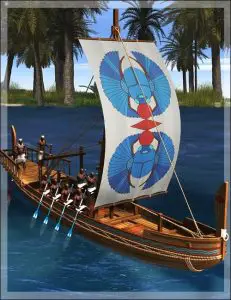There were many means of transportation in ancient Egypt. There were boats, ships, chariots, sleds, donkeys, camels, carrying chairs etc. It is interesting to note that one of the most common means of Egyptian Transport was, by foot.

The Egyptians used sandals, but when walking long distances, they seem to have carried them in their hands and put them on when arriving at their destination.
Mostly elderly people used walking sticks. A day’s march was between 20 and 40 kilometers. Many of the roads were the result of canal digging. Carrying chairs were borne by men, but they were apparently adapted and strapped to the back of donkeys. In the Later periods, they were used for ostentation only.
Horses Uses as Egyptian Transport
For their daily use, even the pharaohs preferred the chariot. Horses were introduced into Egypt by the Hyksos in the 17th century. Usually, men would stand in the chariot, which was like a small open carriage pulled by one or two horses. A chariot could go about 25 miles per hour.
The horses were controlled and steered by reins. But as they were expensive to keep, they served only to the wealthy and never became a popular means of transport. Sledges were wheeled vehicles, but they were not widely used. Water was poured on the soil to facilitate easy movement of sleds.
Donkeys, the “beasts of burden” were always used for carrying loads and so were in Ancient Egypt. They were kept in large numbers throughout Egypt in spite of their not very docile character. In Ramesside times the temple of Amen alone had 11 million donkeys on its lands.
The animal that most Egyptians owned or rented was a camel. Camels were introduced into Egypt in large numbers by the invading Persians. The Egyptians wanted camels because they could go a long way without water, food, and rests.
They could also carry heavy loads on their backs. It was so important that camels could go a long way without water because there was not a lot of water or food in the deserts where the Egyptians lived.
A community, settled in the valley of Nile, would have obviously made use of the waterways, an excellent means of transport. Rafts, boats, and ships were used extensively.
Not all people owned boats. These ranged from small canoes to large barges for carrying heavy freight. As wood was scarce and expensive these were usually made from reeds which grew along the banks of the Nile.
Their boats were a little bit smaller than a sailboat and they were made out of straw. Egyptians moved their boats with oars. Ferry boats too prevailed. The speed of traveling on the river depended on the direction of the journey, the strength of the wind and the current, the boat and its crew. Generally, one did not travel on the Nile in the dark.
One of the reasons by which Egypt grew rich was the Egyptian Transport of raw materials and export of finished products. A more or less feasible system of transportation was a chief reason for their prosperity.
